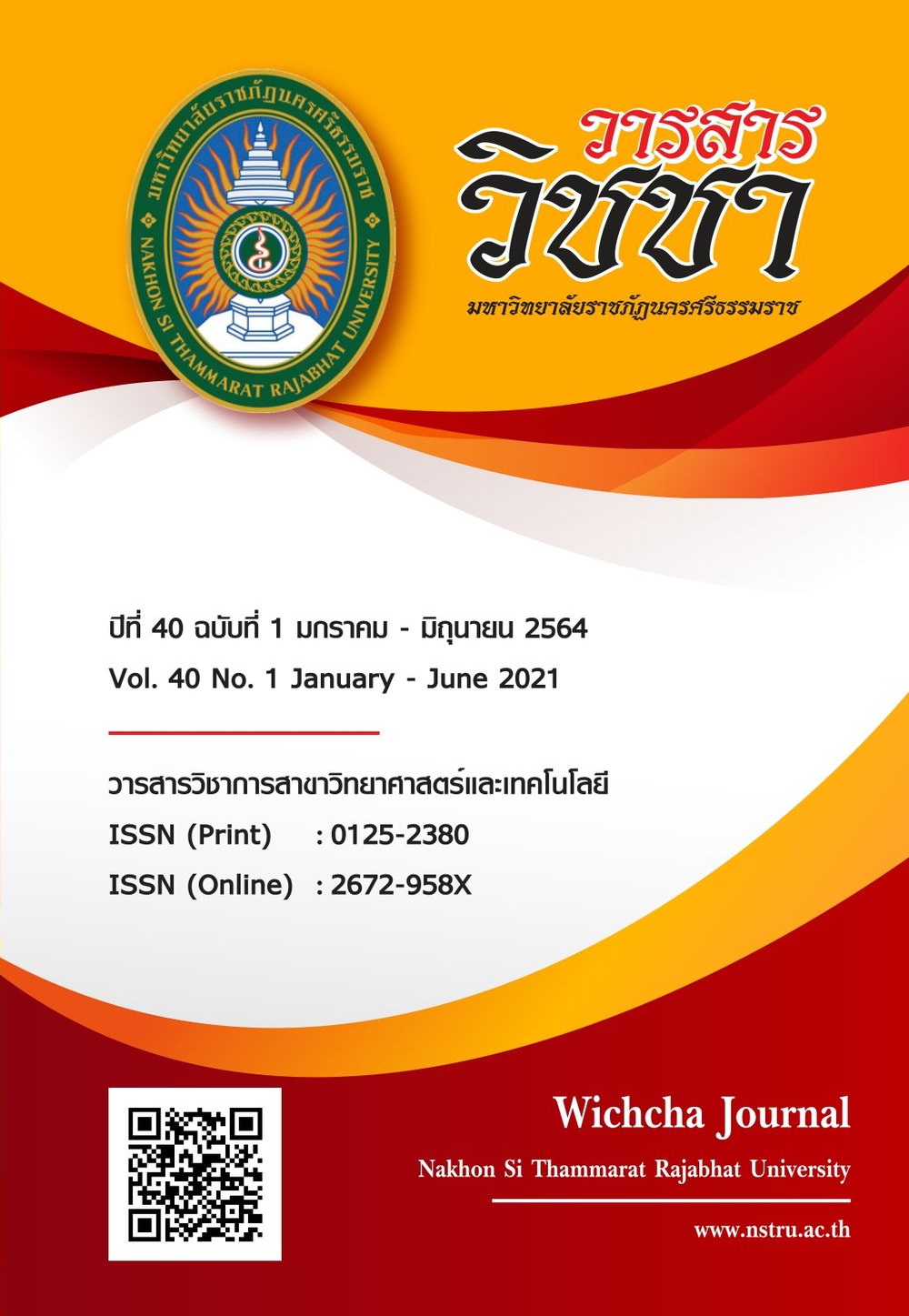Effects of cyannobacteria, Nostoc commune Vaucher TISTR 8870 supplementation on growth, feed utilization and coloration of Siamese fighting fish (Betta splendens Regan, 1910) ผลของการเสริมสาหร่ายสีเขียวแกมน้ำเงิน Nostoc commune Vaucher TISTR 8870 ต่อการเจริญเติบโต ประสิทธิภาพการใช้อาหารและการสร้างสีของปลากัด (Betta splendens Regan, 1910)
Main Article Content
Abstract
The objective of this research was to study the growth, feed utilization, and coloration of Siamese fighting fish (Betta splendens Regan, 1910) fed with Nostoc commune Vaucher TISTR 8870 supplemented diets. The 6-week-old fish (0.72±0.09 g) were fed with experimental diets containing five inclusion levels of N. commune (0.0, 1.0, 2.5, 5.0 and 10.0%), comprising fifteen fish each, over eight-week duration. The fish fed control and 1.0% N. commune containing diets exhibited superior average body weight, average body length, daily weight gain and percentage of daily weight gain, as compared to remaining treatments (p < 0.05), while survival rate was 100±0.00% in all dietary treatments. Significantly positive feed conversion ratio was obtained in fish fed 1.0% N. commune containing diet relative to remaining treatments (p < 0.05). The lightness, redness and yellowness did not differ between fish fed control and N. commune containing diets (p > 0.05). Specific activities of pepsin and chymotrypsin were not different, whereas specific activity of lipase was high in fish fed control diet and the diets containing 1.0 and 2.5% N. commune (p > 0.05). The differences in average pH and temperature were found over experimental duration (p < 0.05). The lowest pH (6.24±0.10) and temperature (26.34±0.03 °C) were recorded in respective treatments of control and 2.5% N. commune containing diet. There was no statistical difference in dissolved oxygen ammonia concentration in all dietary groups (p > 0.05). Findings from the current study indicate that fish fed diet containing 1.0% N. commune contributes the lowest conversion ratio, reducing the cost for commercial production of Siamese fighting fish farming.
Article Details
เนื้อหาและข้อมูลในบทความที่ลงตีพิมพ์ในวารสารวิชชา มหาวิทยาลัยราชภัฏนครศรีธรรมราช ถือเป็นข้อคิดเห็นและความรับผิดชอบของผู้เขียนบทความโดยตรง ซึ่งกองบรรณาธิการวารสารไม่จำเป็นต้องเห็นด้วยหรือร่วมรับผิดชอบใด ๆ
บทความ ข้อมูล เนื้อหา รูปภาพ ฯลฯ ที่ได้รับการตีพิมพ์ในวารสารวิชชา มหาวิทยาลัยราชภัฏนครศรีธรรมราช ถือเป็นลิขสิทธ์ของวารสารวิชชา มหาวิทยาลัยราชภัฏนครศรีธรรมราช หากบุคคลหรือหน่วยงานใดต้องการนำข้อมูลทั้งหมดหรือส่วนหนึ่งส่วนใดไปเผยแพร่ต่อหรือเพื่อการกระทำการใด ๆ จะต้องได้รับอนุญาตเป็นลายลักษณ์อักษรจากวารสารวิชชา มหาวิทยาลัยราชภัฏนครศรีธรรมราชก่อนเท่านั้น
The content and information in the article published in Wichcha journal Nakhon Si Thammarat Rajabhat University, It is the opinion and responsibility of the author of the article. The editorial journals do not need to agree. Or share any responsibility.
References
เทพรัตน์ อึ้งเศรษฐพันธ์ ยุวดี พีรพรพิศาล และนิวุฒิ หวังชัย. (2554) ผลของการเสริม Spirulina platensis ในอัตราที่ต่างกันต่อการเจริญเติบโตและโครงสร้างกรดไขมันของปลานิลแดง (Oreochromis mossambicus x O. niloticus). การประชุมวิชาการสาหร่ายและแพลงก์ตอนแห่งชาติ ครั้งที่ 5. สงขลา: มหาวิทยาลัยสงขลานครินทร์.
ปาริชาต นิลวิเชียร อานนท์ สรรพจักร และนิรันดร ภวันู. (2563). ผลของสไปรูลินาต่อประสิทธิภาพการเจริญเติบโต อัตรารอดตาย ความเข้มสีผิวและการสะสมแคโรทีนอยด์ของปลาสอดแดง. แก่นเกษตร, 48 (ฉบับพิเศษ 1), 953-958.
สุนีรัตน์ เรืองสมบูรณ์ ศักดิ์ชัย ชูโชติ และปวีณา ทวีกิจการ. (2555). การใช้อาหารผสมไซยาโนแบคทีเรีย Nostoc commune สดและแห้งในการเลี้ยงปลาหมอสี Kenyi cichlid, Pseudotropheus lombardoi. วารสารวิทยาศาสตร์ มหาวิทยาลัยขอนแก่น, 40, 208-217.
อดิศักดิ์ เกลี้ยงตะพงศ์ การุณ ทองประจุแก้ว และสมรักษ์ รอดเจริญ. (2561). การเจริญเติบโตของปลาทองออแรนดา (Carassius auratus) ที่เลี้ยงด้วยอาหารผสมสาหร่ายสีเขียวแกมน้ำเงิน Hapalosiphon welwitschii TISTR 8237. วารสารวิจัยมหาวิทยาลัยเทคโนโลยีราชมงคลศรีวิชัย. 10(3), 356-367.
อดิศักดิ์ เกลี้ยงตะพงศ์. (2559). สภาวะที่เหมาะสมในการเลี้ยงสาหร่ายสีเขียวแกมน้ำเงิน Hapalosiphon sp. เพื่อเป็นอาหารปลาทองออแรนดา (Carassius auratus). วิทยานิพนธ์วิทยาศาสตรมหาบัณฑิต. มหาวิทยาลัยเทคโนโลยีราชมงคลศรีวิชัย วิทยาเขตตรัง, ตรัง.
อาภารัตน์ มหาขันธ์. (2546). การเพาะเลี้ยงสาหร่ายน้ำจืด. กรุงเทพฯ: ศูนย์จุลินทรีย์ สถาบันวิจัยวิทยาศาสตร์และเทคโนโลยีแห่งประเทศไทย.
AOAC. (2005). Official methods of analysis. (18th ed.) Washington, DC: Association of Official Analytical Chemists.
APHA, AWWA and WPCF. (1998). Standard methods for the examination of water and wastewater. (20th ed.) Washington, DC: Water Pollution Control Federation.
Bureau, D.P., Kaushik, S.J. and Cho, C.Y. (2002). Bioenergetics. In Halver, J.E. and Hardy, R.W. (Eds.). Fish Nutrition, pp. 1-59. San Diego: Academic Press Inc.
Liao, W.L., Nur, E., Borhan, S., Okada, S., Matsui, T. and Yamaguchi, K. (1993). Pigmentation of culture black tiger prawn by feeding a Spirulina sp. supplemented diet. Nippon Suisan Gakkaishi, 59(1), 165-159.
Lowry, O.H., Rosenbrough, N.J., Farr, A.L. and Randall, R.J. (1951). Protein measurement with the Folin phenol reagent. Journal of Biological Chemistry, 193(1), 265-275.
Peiiaflorida, V.D. and Golez, V.D. (1996). Use of seaweed meals from Kappaphycus aluarezii and Gracilaria heteroclada as binders in diets for juvenile shrimp Penaeus monodon. Aquaculture, 143(3-4), 393-401.
Qiu, B., Liu, J., Liu, Z. and Liu, S. (2002). Distribution and ecology of the edible cyanobacterium Ge-Xian-Mi (Nostoc) in rice fields of Hefeng Country in China. Journal of Applied Phycology, 14, 423-429.
Rountos, K.J., Kim, J.J., Hattenrath-Lehmann, T.K. and Gobler, C.J. (2019). Effects of the harmful algae, Alexandrium catenella and Dinophysis acuminata, on the survival, growth, and swimming activity of early life stages of forage fish. Marine Environmental Research, 148, 46-56.
Rungruangsak-Torrissen, K., Moss, R., Andresen, L.H., Berg, A. and Waagbø, R. (2006). Different expressions of trypsin and chymotrypsin in relation to growth in Atlantic salmon (Salmo salar L.). Fish Physiology and Biochemistry, 32(1), 7-23.
Sattanathan, G., Palanisamy, T., Padmapriya, S. Arumugam, V.A., Park, S., Kim, I.H. and Balasubramanian, B. (2020). Influences of dietary inclusion of algae Chaetomorpha aerea enhanced growth performance, immunity, haematological response and disease resistance of Labeo rohita challenged with Aeromonas hydrophila. Aquaculture Reports, 17, doi: https://doi.org/10.1016/j.aqrep.2020.100353.
Thongprajukaew, K., Kovitvadhi, U., Kovitvadhi, S., Somsueb, P. and Rungruangsak-Torrissen, K. (2011). Effects of different modified diets on growth, digestive enzyme activities and muscle compositions in juvenile Siamese fighting fish (Betta splendens Regan, 1910). Aquaculture, 322-323, doi: https://doi.org/10.1016/j.aquaculture.2011.10.006.
Winkler, U.K. and Stuckmann, M. (1979). Glycogen, hyaluronate and some other polysaccharides greatly enhance the formation of exolipase by Serratia marcescens. Journal of Bacteriology, 138(3), 663-670.
Worthington, V. (1993). Worthington enzyme manual. Enzymes and related biochemicals. New Jersey: Worthington Chemical.
Zar, J.H. (1996). Biostatistical analysis. (3rd ed.) Englewood Cliffs, NJ: Prentice-Hall.


